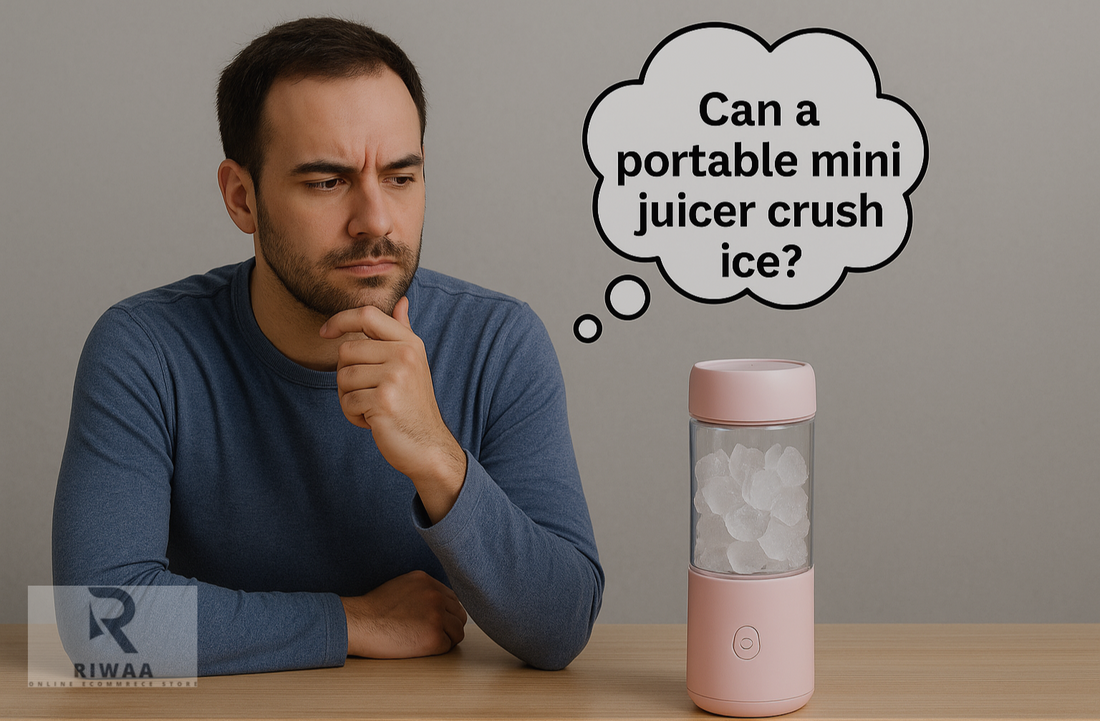
Can a Portable Mini Juicer Crush Ice? Truth Revealed!
Discover if portable mini juicers can crush ice, what works best, and tips to protect your device while making smoothies, frappes, and slushies.
Introduction
Portable mini juicers have become one of the most popular kitchen gadgets for people who value convenience, especially in countries like Pakistan where fresh juices, smoothies, and shakes are part of everyday life. They are compact, easy to carry, and perfect for travel, gym, or office use. But one question almost every buyer asks is: Can a portable mini juicer crush ice? This guide provides a detailed answer while also covering how these devices work, their limitations, and practical tips to get the best results.
What Exactly Is a Portable Mini Juicer?
A portable mini juicer is a compact, battery-powered appliance designed to make juices, smoothies, and shakes on the go. Unlike heavy countertop juicers and blenders, it usually combines the jar and motor in one sleek unit, making it easy to carry and clean.
Juicer vs. Blender: Key Differences
Here is the difference between a blender, juicer and portable juicer or blender
-
Juicer: Separates juice from pulp and fiber, producing clear liquid.
-
Blender: Crushes and blends whole fruits or vegetables, retaining fiber.
-
Mini Juicer-Blender Combo: Portable models are closer to blenders, with limited juicing capability.
Motor, Blades, and Jar Design Explained
-
Motor: Low-powered compared to countertop models, usually 40–150 watts.
-
Blades: Made from stainless steel, often 2–6 in number, designed for soft fruits.
-
Jar: Usually plastic or glass, 300–500 ml capacity, detachable for drinking.
Battery vs. Plug-In Models
-
Battery-Powered: Rechargeable via USB, portable, ideal for outdoor and travel use.
-
Plug-In: Slightly more powerful, but less portable.
Can a Portable Mini Juicer Crush Ice?
Yes — but with limits. Portable mini juicers are designed mainly for soft fruits and smoothies, not heavy-duty ice crushing. Their smaller motors and compact blades can handle ice only when used smartly — like with smaller chunks, added liquid, and short bursts. If you expect “snow ice” like in a café frappe, results will often be inconsistent. Still, for travel smoothies, iced coffee, or light mocktails, many portable juicers can crush enough ice to get the job done.

Why Brands Claim ‘Ice-Crushing’ Ability
Marketing vs. Reality: What Manufacturers Mean
Most brands advertise “ice-crushing” to grab attention, but the term is often misleading. What they mean is light ice blending — not breaking down large cubes into fine powder. In practice, portable juicers can usually manage pre-crushed or small nugget ice when combined with liquids. Without this, the motor may stall, blades may chip, or the battery can overheat.
Factors That Decide Ice-Crushing Success
Crushing ice with a portable juicer depends on multiple technical and practical factors:
Motor Power & Torque (Not Just Watts)
It’s not just about wattage. A 50–150W portable juicer may sound weak, but torque (rotational force) is what matters. A stronger motor with good torque can crush ice more effectively in short bursts. Cheap models with low torque tend to stall or overheat quickly.
Blade Shape and Material
Blades are the real warriors. Serrated stainless steel blades cut ice better than flat ones, as they grip and shatter chunks instead of just spinning. Hardened stainless steel also resists dulling — crucial since ice is much harder than fruit.
Jar Size, Shape, and Capacity
Jar design affects how ice moves inside. A narrow-bottom jar creates a better vortex, pulling ice toward the blades. Overfilling or using a wide, shallow jar causes uneven crushing. Ideally, fill only up to two-thirds capacity for best results.
Battery Life, Voltage, and Duty Cycle
Most portable juicers run on 3.7V to 7.4V batteries. Higher voltage gives stronger bursts, but shortens runtime. If the juicer lacks proper duty cycle limits (time between pulses), the motor can overheat or drain the battery. Always pulse in intervals to protect performance.
Ice Type: Cubes, Nuggets, or Pre-Crushed
Not all ice is equal. Big solid cubes are a nightmare for mini juicers. Instead, use nugget ice (softer, chewable type) or pre-crushed ice. If you only have cubes, break them with a mallet first. Smaller pieces reduce stress on the motor and blades.
Liquid Ratio: Why Adding Water Matters
Never try to crush ice dry in a mini juicer. Adding a small amount of water, juice, or milk helps ice circulate and prevents blades from jamming. A good rule: 2 parts ice, 1 part liquid. This also gives smoother, slush-like results.
How to Crush Ice with a Portable Juicer (Step-by-Step Guide)
Crushing ice in a portable juicer requires technique more than raw power. Follow this process to avoid damage and get the smoothest possible results.
Step 1 — Prep Smaller Ice Chunks
Never drop whole ice cubes into a mini juicer. Instead, wrap cubes in a kitchen towel and break them into smaller chunks using a rolling pin or mallet. Smaller pieces reduce motor strain and blend more evenly.
Step 2 — Add Liquid Before Ice
Always start with a little liquid (water, juice, or milk) before adding ice. This prevents blades from spinning dry and helps ice circulate smoothly. Without liquid, your motor may jam.
Step 3 — Load Smart, Avoid Overfilling
Fill only two-thirds of the jar at most. Overloading leaves no space for movement, leading to uneven crushing. Balance ice with fruits or liquids for better texture.
Step 4 — Pulse in Short Bursts
Portable juicers are not designed for long, continuous runs. Instead, use 2–3 second bursts, pause, then repeat. This technique gives blades time to reset and reduces overheating risk.
Step 5 — Shake or Tap Between Pulses
If ice gets stuck, don’t force the motor. Instead, give the juicer a gentle shake or tap the base on your palm. This loosens ice and helps it fall toward the blades.
Step 6 — Serve Quickly Before Melting
Mini juicers don’t insulate like big blenders. Once ice is crushed, serve right away. Waiting too long turns your ice into a watery mix.
Pro Tips for Smooth Snow-Like Ice
-
Use soft nugget ice or pre-crushed ice for best texture.
-
Chill the jar before blending to slow melting.
-
Combine ice with fruits for natural slushies instead of plain water ice.

What Not to Do (Mistakes That Damage Your Juicer)
-
Overloading: Stuffing the jar with too much ice blocks circulation and overheats the motor.
-
Dry blending: Running the blades with only ice and no liquid increases wear.
-
Running continuously: Holding the button for 30+ seconds can burn out the battery or motor.
Safety & Care While Crushing Ice
Crushing ice in a portable mini juicer is possible, but it’s tough on the machine. Proper safety and care keep your juicer running longer and prevent damage.
Avoid Overheating & Motor Strain
Ice is harder than fruit, so the motor works under extra load. If your juicer feels warm or starts slowing down, stop immediately. Allow it to rest for a few minutes before resuming. This prevents overheating, battery drain, and long-term motor burnout.
Protecting Blades, Seals, and Battery
-
Blades: Even stainless-steel blades dull faster when used on ice. Keep usage occasional, not daily.
-
Seals: Check rubber gaskets after crushing ice. Cracks or leaks weaken performance.
-
Battery: Crushing ice drains more power than blending fruit. Avoid running it on low battery, as this strains the motor. Charge fully before use.
Troubleshooting: When Your Mini Juicer Struggles
Even with proper technique, mini juicers sometimes stall or produce uneven results. Here’s how to fix common issues.
Chunky or Uneven Ice
If the ice comes out chunky instead of smooth, you may have:
-
Added too much ice at once
-
Skipped adding liquid
-
Used large, solid cubes
Fix: Use smaller pieces, add a splash of liquid, and blend in short bursts.
Juicer Stalls or Stops
When the motor stops suddenly, it usually means the jar is overloaded. Some juicers also have auto-shutoff for protection.
Fix: Remove some ice, let the motor rest, then restart with smaller loads.
Strange Smells or Noises
A burning smell, grinding sound, or rattling noise signals stress on the motor or misaligned blades.
Fix: Stop immediately. Check if ice is jammed under blades, inspect seals, and let the motor cool before trying again.
Realistic Expectations: What Mini Juicers Can & Can’t Do
Portable mini juicers are handy, but they have limits.
What They Can Do:
-
Crush small, soft ice (like nuggets or pre-crushed).
-
Handle blended drinks like smoothies, shakes, iced coffees, and slushies.
-
Work well for travel, office, and light use.
What They Can’t Do:
-
Replace a full-size blender or professional ice crusher.
-
Consistently make bar-style crushed ice.
-
Handle continuous or heavy-duty ice crushing without damage.
Think of them as a convenient travel tool, not a heavy-duty kitchen machine.

Fun Use Cases Beyond Smoothies
Portable mini juicers are not limited to fruit blends. With ice-crushing ability, you can enjoy a wider range of refreshing drinks.
Iced Coffee & Frappes
Blend chilled milk, instant coffee, sugar, and ice for a café-style frappe. Mini juicers can easily handle pre-crushed or nugget ice for a smooth, refreshing coffee experience on the go.
Mocktails, Shakes, and Slushies
Mix fruit syrups, juices, or sodas with ice to create colorful mocktails. For kids, milkshakes and slushies are quick to make. Just ensure smaller ice pieces for even blending.
Sports & Travel Drinks
Athletes and travelers can prepare electrolyte mixes, protein shakes, or chilled hydration drinks by blending powders, liquids, and a few ice chunks for instant refreshment.
Alternatives If You Crush Ice Regularly
If ice is a daily requirement, consider alternatives that save your mini juicer from excess strain.
Manual Mallet or Rolling Pin Method
Place ice cubes in a sealed bag and crush with a mallet or rolling pin. Simple, inexpensive, and easy to control.
Dedicated Ice Crusher
Manual or electric ice crushers are built specifically for heavy ice use. They produce consistent crushed ice, perfect for cocktails and large gatherings.
High-Power Countertop or Portable Blender
Blenders with higher wattage and strong blades handle ice with ease. A good option if you want frequent ice-based drinks without damaging a mini juicer.
Buying Guide: Choosing a Mini Juicer That Handles Ice
Not all portable juicers are equal. Look for features that improve ice performance and durability.
Minimum Specs to Look For
-
Motor: At least 150–200 watts or strong torque design
-
Blades: 4–6 stainless steel blades with reinforced edges
-
Jar Capacity: 350–500 ml with thick, durable material
-
Battery: 2000mAh or higher for stable blending power
Warranty, Spare Parts, and Service in Pakistan
Before buying, check if the brand offers warranty and spare parts locally. Many imported models lack service support, so choose a seller who provides after-sales assistance in Pakistan.
Nice-to-Have Extras (Pulse Mode, Thermal Protection)
-
Pulse Mode: Allows short bursts, ideal for ice crushing.
-
Thermal Protection: Auto shut-off prevents overheating.
-
Safety Lock: Ensures the jar is secured before blending.
These extras extend lifespan and improve safety when using ice.
Cleaning & Maintenance After Ice Crushing
Proper care after using ice ensures your portable mini juicer stays efficient and lasts longer.
Cleaning After Ice Use to Prevent Rust
Always rinse the blades and jar immediately after crushing ice. Leaving melted water inside may cause rusting, especially on lower-quality steel parts. Use mild soap, rinse well, and dry thoroughly.
Avoiding Dull Blades
Ice can wear down blades over time. To reduce dullness, avoid blending large, hard cubes. Stick to smaller pieces or pre-crushed ice, and do not run the juicer empty.
Battery Care for Longer Lifespan
Recharge the juicer only when the battery is low. Avoid overcharging and store the device with at least 40–50% battery if unused for long periods. This prevents battery damage and ensures stable performance.
Conclusion
Portable mini juicers can crush ice, but within limits. They work best with small chunks, liquid added, and pulsing in short bursts. With proper care, they can prepare smoothies, frappes, and mocktails on the go. However, for frequent or heavy ice crushing, consider alternatives like a dedicated ice crusher or a high-power blender.
FAQ’s
Can all portable mini juicers crush ice?
Not every portable mini juicer is built to handle ice. Only models with strong motors, stainless steel blades, and sturdy jars can manage small chunks. Always check the manufacturer’s specifications before trying to crush ice in your device.
Is it safe to crush ice daily in a mini juicer?
Daily ice crushing is not ideal for mini juicers. While they can handle occasional use, frequent ice blending strains the motor and dulls blades. Over time, this shortens the device’s lifespan and reduces performance, so moderation is recommended.
Can I crush large ice cubes in a portable juicer?
Large, hard cubes are risky for mini juicers. They can jam the blades or damage the motor. Always break ice into smaller chunks or use pre-crushed ice for smoother results and to protect your portable juicer from wear.
Why does my mini juicer stop while crushing ice?
Your juicer may stop because it’s overloaded, the motor is overheating, or the battery is low. Crushing large ice pieces without liquid can cause stalls. Always add liquid, pulse in short bursts, and avoid overfilling the jar.
How do I extend my mini juicer’s life if I crush ice often?
To extend lifespan, crush only small ice chunks, always add liquid, and avoid continuous running. Clean blades after each use to prevent rust, recharge the battery correctly, and store the juicer dry. Smart usage ensures long-lasting performance.







